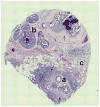Breast cancer complexity: implications of intratumoral heterogeneity in clinical management
- PMID: 28752247
- PMCID: PMC5693662
- DOI: 10.1007/s10555-017-9684-y
Breast cancer complexity: implications of intratumoral heterogeneity in clinical management
Abstract
Generation of intratumoral phenotypic and genetic heterogeneity has been attributed to clonal evolution and cancer stem cells that together give rise to a tumor with complex ecosystems. Each ecosystem contains various tumor cell subpopulations and stromal entities, which, depending upon their composition, can influence survival, therapy responses, and global growth of the tumor. Despite recent advances in breast cancer management, the disease has not been completely eradicated as tumors recur despite initial response to treatment. In this review, using data from clinically relevant breast cancer models, we show that the fates of tumor stem cells/progenitor cells in the individual tumor ecosystems comprising a tumor are predetermined to follow a limited (unipotent) and/or unlimited (multipotent) path of differentiation which create conditions for active generation and maintenance of heterogeneity. The resultant dynamic systems respond differently to treatments, thus disrupting the delicate stability maintained in the heterogeneous tumor. This raises the question whether it is better then to preserve stability by preventing takeover by otherwise dormant ecosystems in the tumor following therapy. The ultimate strategy for personalized therapy would require serial assessments of the patient's tumor for biomarker validation during the entire course of treatment that is combined with their three-dimensional mapping to the tumor architecture and landscape.
Keywords: Breast cancer; Clinical models; Heterogeneity; Stem cells; Tumor ecosystem.
Figures



References
-
- Fidler IJ. Tumor heterogeneity and the biology of cancer invasion and metastasis. Cancer Research. 1978;38:2651–2660. - PubMed
-
- Heppner GH, Miller BE. Tumor heterogeneity: biological implications and therapeutic consequences. Cancer Metastasis Reviews. 1983;2:5–23. - PubMed
-
- Dexter DL, Kowalski HM, Blazar BA, Fligiel Z, Vogel R, Heppner GH. Heterogeneity of tumor cells from a single mouse mammary tumor. Cancer Research. 1978;38:3174–3181. - PubMed
-
- Marusyk A, Almendro V, Polyak K. Intra-tumour heterogeneity: a looking glass for cancer? Nature Reviews Cancer. 2012;12:323–334. - PubMed
-
- Nowell PC. The clonal evolution of tumor cell populations. Science. 1976;194:23–28. - PubMed
Publication types
MeSH terms
Grants and funding
LinkOut - more resources
Full Text Sources
Other Literature Sources
Medical

